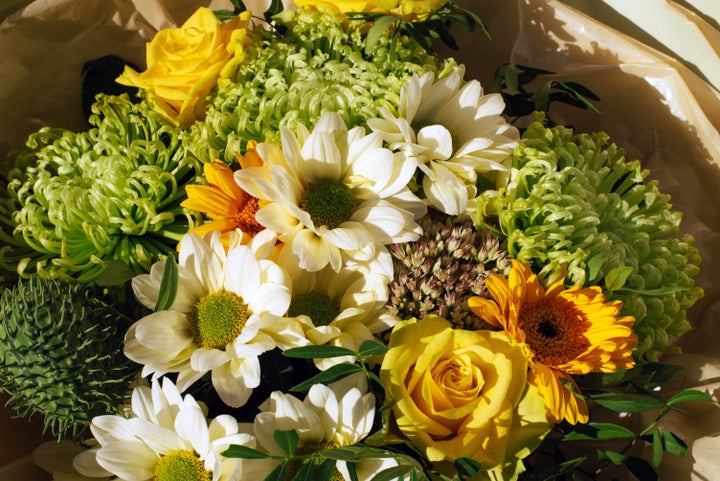
Is there any gift more reliable for Mother’s day than the classic bouquet of flowers?
They’re bright, colourful and mums tend to love them but there is one downfall — cut flowers don’t tend to last very long, and it can almost feel like a waste when you’re throwing out flowers the same week that you got them.
However, according to Julian de Bosdari, CEO of UK plant nursery Ashridge, there are ways to prevent this premature wilting and they don’t require you to be a seasoned greenfingers.
After years of watching our bouquets slowly decay, we’re all ears.
The cheap secret is actually making your own flower food!
How to make your own flower food for just 5p per use
You often get a small sachet of liquid flower food with your bouquet, so make sure to add this to the water, when you first put them in a vase. To extend the bouquet’s shelf life, aim to add additional flower food each time that you replace the water.
If you can’t get hold of proper flower food or aren’t looking to fork out, de Bosdari has a cheap solution: “If you pick up a pack of granulated sugar (£1.09) and distilled white vinegar (35p) from Tesco, you can make flower food mixture for just 5p each time you replace the vase water.”
The sugar provides energy to nourish the flowers, while the white vinegar lowers the water’s pH, which improves water absorption and helps to remove bacteria from the water due to its antimicrobial properties.
In fact, there are quite a few secrets to keeping your bouquets around for longer and most of them are simple!
How to make bouquets of flowers last longer
Make sure that they’re going in a clean vase
De Bosdari urges that before anything else, you should make sure that your vase is completely clean. He urges that vases with narrow openings are typically harder to clean and prone to trapping bacteria, which can contaminate the water and cause flowers to age and decompose quicker so, if possible, opt for a vase with a wider opening.
Opt for a glass or ceramic vase
If possible, ensure that your flowers are placed in a glass or ceramic vase as with plastic vases, the porous material is more likely to harbour bacteria. Plus, de Bosdari adds, glass and ceramic vases tend to elevate the look of bouquets.
Make sure that the stems have been cut at an angle
Even if you purchased pre-cut bouquets, these are likely to have closed by the time that you purchased them. Therefore, de Bosdari says, it’s important to trim half an inch off each stem at a 45 degree angle using a clean knife or pair of sharp scissors before setting your flowers in a vase.
This maximises the surface area for water absorption, allowing flowers to stay more hydrated. For an even better chance of a long-life, make sure that you trim the stems of your flowers every couple of days.
Remove foliage below the water line
If you have any leaves or petals submerged in your vase water, these should be removed as they can promote bacterial growth. Bacteria clogs the stems, obstructing water absorption and shortening the lifespan of flowers.
However, de Bosdari says, you can keep any healthy foliage that is above the water line to preserve the bouquet and make it look as full as possible.
Keep flowers out of sunlight and away from fruit
While our flowers seem perfectly suited to sit on windowsills, de Bosdari urges that flowers should be kept away from direct sunlight and heat sources as they can cause wilting and premature blooming, shortening the bouquet’s lifespan/
Instead, best to place your flowers in a cooler environment with plenty of indirect light rather than directly within the sun’s rays or near a radiator.
Keep flowers away from fruits
While fruits and flowers together may sound like a still-life dream, de Bosdari warns that ripening fruits such as bananas and apples produce an odourless gas called ethylene which causes flowers to age and drop petals more quickly.
Change the vase water regularly
De Bosdari said: “Make sure the water in your vase is clean and change it often to remove any bacteria. This should be done every two days, but you can also do it daily, especially for more delicate varieties.”
Check on your flowers often and handle them with care
Ensure that you regularly check up on your flowers and remove wilting petals. This is not only good for the look of your flowers but prevents the spread of bacteria in the vase water.
Cutting off wilting foliage also gives new buds space to bloom, resulting in a flourishing bouquet that’s even bigger and more beautiful.
Though some flower varieties are highly durable, it’s a good idea to be gentle when handling your bouquet. Avoid crushing or squeezing the stems as this can cut off water uptake to the plant.
Petals are particularly delicate – treat them with care to prevent any damage and keep them looking their best.
The best flowers to buy for long-lasting bouquets
If you’re thinking ahead to the next floral occassion, de Bosdari advises buying flowers that tend to last longer: “Chrysanthemums, carnations and orchids are more durable varieties that can survive for several weeks and enable your loved one to enjoy their bouquet for longer.
“On the other hand, more delicate varieties, such as tulips and peonies, have a vase life of around five days, and are likely to wilt much more quickly.”
Noted.